There are a number of factors that can cause apples to turn brown or get brown spots. If you are wondering if you can eat apples with brown spots, it is important to identify what is causing the brown spot before you munch into it.
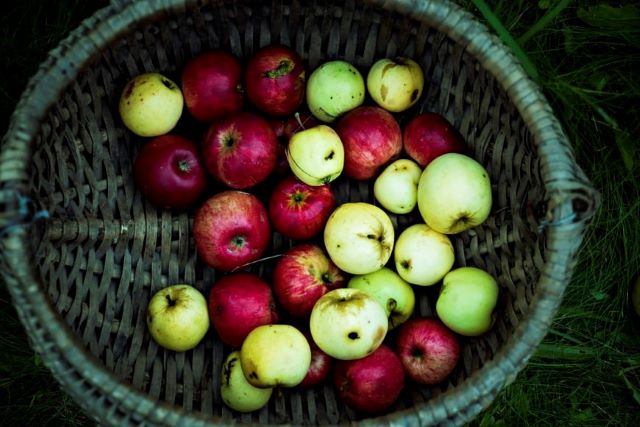
Related: 8 Best Apple Juicers | Eating Crab Apples | Why is My Apple Bitter?
Table of Contents
Reasons Apples Get Brown Spots
When apples are cut open and left exposed to the air, the flesh will begin to turn brown.
This is due to an enzyme in the apple called polyphenol oxidase. This enzyme starts to oxidize compounds in the apple’s flesh called polyphenols. This enzymatic change causes the white flesh of the apple to turn brown.
This is normal and can even have health benefits. Browned, or oxidized, apple has long been used as a treatment for nausea and stomach ailments.
The brown spots we are talking about here are not the browning caused by exposure to air.
Here are some of the most common causes of brown spots on apples.
Fungal Infections Cause Brown Spots on Apples
Bitter Rot
This fungus causes sunken brown spots to form on the skin of the apple. The brown spots grow in size and darken in color as the fruit ripens.
The flesh beneath the brown spot is also affected and turns brown in a cone shape with the small end towards the core. The fungus spreads with time and eventually the whole fruit will turn black and shrivel up.
Can you eat the apple affected by bitter rot? You can eat unaffected parts of the apple in the early stages. Cut away the brown areas caused by bitter rot and use the remaining parts of the apple.
Once the apple has been picked, eat or process it immediately as the rot will continue to spread rapidly throughout the fruit. Affected areas will taste bitter.
Flyspeck
Flyspeck is caused by a sooty fungal infection that looks a bit like the little black dots flies leave behind.
Can you eat the apple affected by flyspeck? Yes definitely. The inner fruit is undamaged by the fungus. Although it is not harmful to humans, it is recommended that you peel the fruit before eating it if the infestation is severe.
Cedar Apple Rust
Cedar Apple Rust is a fungus that causes brown spots to form on the skin and the flesh just under the skin becomes brown and spongy.
Can you eat the apple affected by Cedar Apple Rust? Cedar Apple Rust is not harmful to humans so you could eat it but the brown areas have a slightly bitter taste and so you may prefer to cut them away before eating or cooking the apples.
Apple Scab
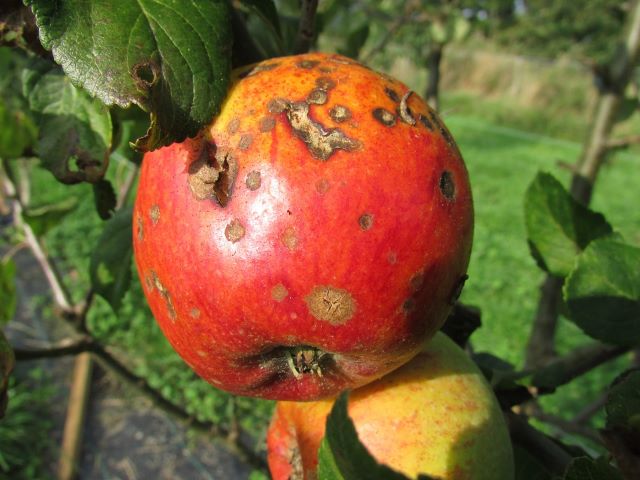
Apple Scab is a fungus that causes hard brown lesions or bumps to form on the skin.
Can you eat the apples affected by Apple Scab? Yes, you can definitely eat unaffected parts of the fruit. This fungus does not penetrate the skin and so, by peeling the apple, you will be left with a perfectly healthy and safe to eat the apple.
If there are only a few lessons, you could just cut these off and enjoy the rest of the apple, skin and all.
Black Fruit Rot
Black Fruit Rot is a blossom end rot and thus starts at the bottom of the apple, where the blossom was. It causes the fruit to turn brown, beginning at the bottom but eventually taking over the whole fruit.
Once the whole apple has turned brown, it will then turn black. The fruit remains firm throughout the process. The fungus can proceed into the core of the fruit causing internal rot.
Can you eat the apple affected by Black Fruit Rot? If the rot has only just begun to set in you could cut the brown bottom end off and eat the rest of the apple. Unfortunately, once the apple has turned brown you should not eat it.
Sooty Blotch
Sooty Blotch fungus appears as dusty black or gray spots on the apple.
Can you eat the apple affected by Sooty Blotch? This fungus is harmless although unsightly. Despite this, it is recommended to peel the apple before eating. The inner flesh is unaffected by the fungus.
Insects and Bugs Cause Brown Spots on Apples
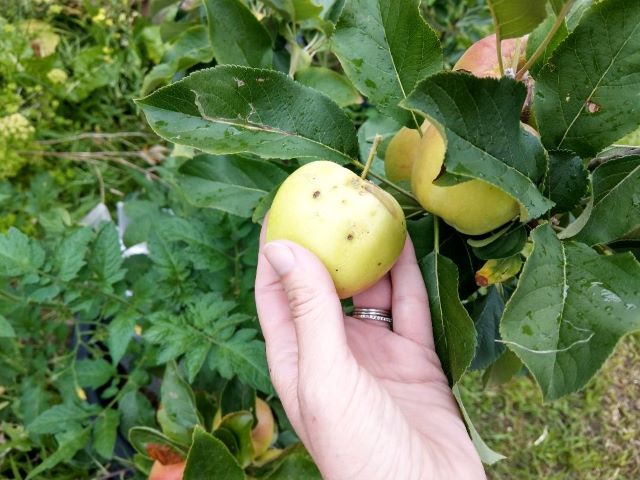
Green Fruit Worms
Green Fruit Worms tunnel into apples turning the fruit around them brown. The longer the worm is in the apple the more damage it will cause to the flesh.
Can you eat the apple affected by Green Fruit Worms? Yes you can, if the worm has not been in the apple long, the majority of the flesh will still be crunchy and delicious. Simply cut away the infected area and enjoy the rest of the apple.
Codling Moths
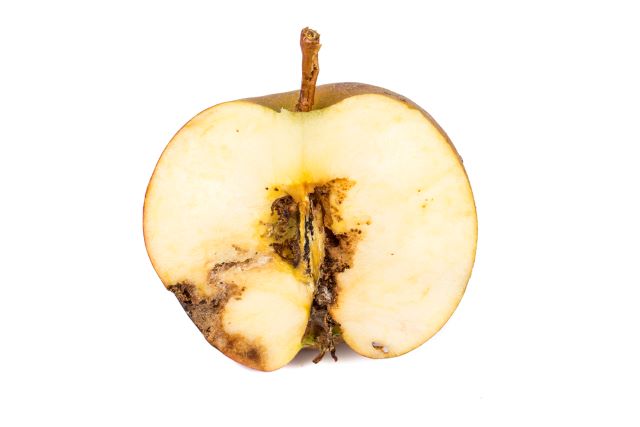
It is the codling moth larva or caterpillars that cause damage to the apples. These burrow into the apple leaving distinct brown spots, and sometimes droppings, where they have entered.
Newly hatched larvae are white with a black head and are small, approximately 3/64 ″ (1mm) long. They can grow to a size of 11/16 ″ (18mm) long. They eat their way towards the core of the apple where they set up home.
Can you eat the apple affected by Codling Moth? Codling Moth larvae tend to contaminate most of the fruit. The larvae are not harmful to eat and are probably a good source of protein if you were desperate, but most people would find it rather disgusting to eat a larvae-infested apple.
Apple Maggot
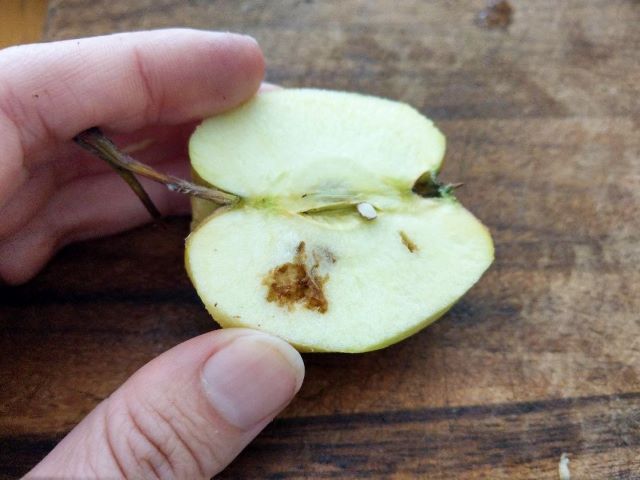
Apple maggots lay eggs inside apples when the apple is still forming. Once the maggot hatches it eats its way out of the apple damaging the flesh.
Once the apple is ripe the maggot has left the apple so you will not see it, but the brown spots remain.
Can you eat the apple affected by Apple Maggot? You can safely eat the apple. The maggot has long gone and only the damaged flesh is left behind to show it was ever there. So, although it may not look too appetizing, it is safe to eat.
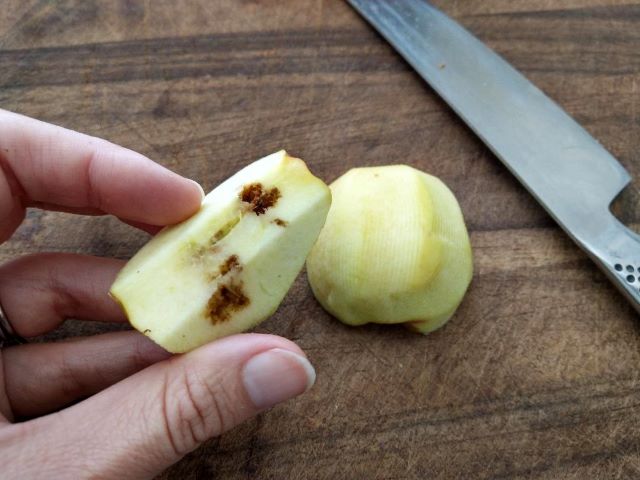
Stink Bug
Adult Stink Bugs pierce the skin of the apple to suck out the juice. This causes a slightly indented area at the puncture site and a light brown corky area just under the skin. A feeding tube can be seen reaching about halfway into the apple towards the core.
Can you eat the apple affected by Stink Bugs? It is best not to eat the infected area but rather cut it out. The rest of the apple should be undamaged and safe to eat.
Incorrect Storage Procedure Cause Apples To Have Brown Spots
Superficial Scald
Apples that have been kept at a very cold temperature for longer than 2 or 3 months will begin to develop brown spots. This is also known as storage scald.
Can you eat the apple affected by Superficial Scald? You can eat apples with these brown spots. The longer they are left in storage, hot or cold, the bigger the spots will become.
Apples that have been held in cold storage too long lose some of their flavor and crisp texture but they are edible.
Sodium Burn
Sodium Burn can occur when apples are washed in sodium hypochlorite, food grade bleach, before distribution. This can also cause brown spots on the skin.
Can you eat the apple affected by Sodium Burn? Sodium Hypochlorite is approved by the EPA for use in food processing. Exposure to large amounts of sodium hypochlorite can cause headaches, dizziness, nausea and vomiting. It is thus recommended that you do not eat apples that have been damaged by an overuse of sodium hypochlorite.
CO2 Damage
CO2 Damage is caused by high concentrations of CO2 during storage. It is more prevalent in certain varieties and in apples harvested later in the season.
It causes the inside of the apple to turn brown. On the outside, the apple looks perfect but when cut open the flesh is brown and unsightly.
Can you eat the apple affected by CO2 Damage? As starches change to sugars in the ripening process of the apple CO2 is given off naturally.
This CO2 can build up in an enclosed storage area and has been found to slow the ripening process. However, if the CO2 levels get too high they can damage the fruit.
Some studies have shown that exposure to high CO2 levels can reduce the nutritional value of the fruit but there is no evidence that it can cause fruit to become harmful.
You can thus safely eat the apple, you might just need 2 apples to get the required nutrients.
Soggy Breakdown
Soggy Breakdown is caused when apples are stored at temperatures too low for them to handle. This causes browning in the cortex.
It can cause some brown spots just below the skin or it can cause a ring of brown around the entire apple. It does not usually extend to the skin but can be seen when the apple is cut open.
Can you eat the apple affected by Soggy Breakdown? You can eat the apple. The browning under the skin is due to cellular breakdown and is therefore harmless to humans. It is unsightly but does not appear to affect the flavor or nutrition of the apple. Some of the crisp texture may be lost.
Soft Scald
Soft Scald is another chilling disorder that occurs when apples are stored at temperatures below their tolerance. It looks like a light brown blister on the skin.
It will darken with time and will affect the flesh beneath it. And it will eventually cause fungal decay.
Can you eat the apple affected by Soft Scald? You can eat the apple in the early stages. Simply cut the blister away or eat it as it is not harmful. Once fungal decay has set in it is best to cut the infected area away. If a large area of the apple has been infected it is best to stay away.
Mineral Deficiencies Cause Brown Spots On Apples
Bitter Pit
Bitter Pit is caused by a lack of calcium. It causes small brown divots to form on the skin, like indentations on a golf ball.
The flesh beneath the hollows also turns brown. It can show up while the apple is still on the tree or a few weeks into storage time.
It usually occurs during hot dry summers as the plant needs sufficient water to enable good calcium absorption. And it is also more common on young, vigorously growing trees, especially those fed heavily with fertilizers containing nitrogen, potassium and magnesium.
The over presence of other minerals can sometimes prevent the proper absorption of calcium.
Can you eat the apple affected by Bitter Pit? You can eat the apple as these brown spots are not harmful to humans as they are caused by a malformation caused due to a calcium deficiency.
The affected flesh is often bitter and unpleasant to eat. If you notice bitter pit on your apples cook them or freeze them straight after picking, as the disorder will spread further after picking.
Conclusions
In conclusion, most apples with brown spots are safe to eat. Removing the brown spots is a good idea but not essential. So the saying: ‘an apple a day keeps the doctor away’ still stands, even for brown spotted ones.
Some of My Favorite Kitchen Items:
Further Reading:
